Struggling with EMI/RF interference in your electronic device? The right shielding can is crucial, but the material choice makes all the difference. As a custom shielding can manufacturer, we see firsthand how material selection impacts performance, manufacturability, and cost. Choosing wrong can lead to shielding failure, production delays, or unnecessary expense. This guide cuts through the complexity to help engineers and procurement specialists select the optimal material for their specific needs.
1.Stainless Steel
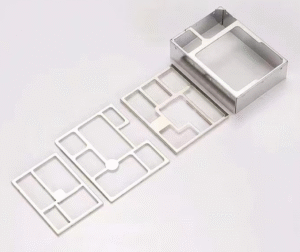
Advantages:
High Strength & Rigidity: Provides excellent structural support, resists deformation.
Excellent Spring Properties: Especially SUS 301, ideal for clips/snaps requiring tension or covers needing frequent removal (e.g., test points).
Good Corrosion Resistance: SUS 304 performs excellently in most environments.
Cost-Effective: Generally less expensive than copper alloys, with relatively stable raw material costs.
Good Magnetic Shielding (H-field): Due to its ferromagnetic properties, offers better low-frequency magnetic field shielding than non-magnetic copper alloys.
Disadvantages:
Lower Electrical Conductivity:Compared to copper alloys, Electric Field Shielding Effectiveness (E-field SE) is slightly weaker at higher frequencies (though usually still sufficient for most requirements).
High Work Hardening Rate:Especially pronounced in SUS 301, requiring more frequent die maintenance or intermediate annealing, increasing difficulty and cost for complex deep drawing.
Solderability Challenges: Typically requires Nickel Plating to ensure good solderability and prevent rusting.
Best For: Applications needing high strength/rigidity, good corrosion resistance, and cost sensitivity; requiring low-frequency magnetic shielding; spring contacts/clips. Common in consumer electronics, industrial controls, automotive electronics main structures.
2.Copper Alloy – Nickel Silver / German Silver (Commonly C7521, C7701)
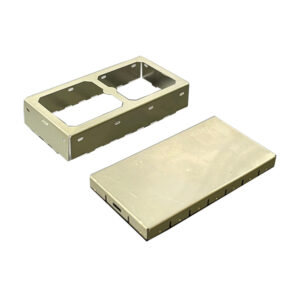
Advantages:
Excellent Corrosion Resistance:Nickel content gives corrosion resistance better than brass, approaching stainless steel. Silvery appearance.
Good Electrical Conductivity: Better than stainless steel.
Good Formability & Solderability: Easy to process, good soldering performance.
Moderate Strength: Falls between brass and stainless steel.
Disadvantages:
Higher Cost: More expensive than stainless steel and brass.
Poor Magnetic Shielding: Non-magnetic.
Best For: Applications needing a balance of good corrosion resistance and conductivity, often requiring a silvery appearance. Common in medical devices, marine environment equipment, high-end consumer electronics visible parts.
3.Copper Alloy – Phosphor Bronze (Commonly C5191, C5210)
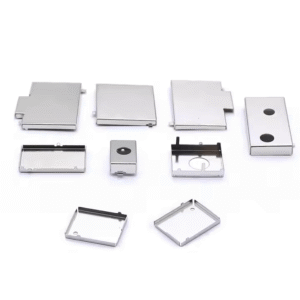
Advantages:
Very High Strength & Superior Spring Properties: Better elasticity and fatigue resistance than brass and most stainless steel (except SUS301). Ideal for spring contacts, battery clips, and frequently removed covers.
Good Electrical Conductivity: Better than stainless steel, provides good E-field shielding.
Good Corrosion & Stress Relaxation Resistance: Maintains elasticity under stress for longer periods.
Good Formability: Better than high-hardness stainless steel, though not quite as good as brass.
Disadvantages:
Highest Cost:Typically the most expensive among common materials.
Lower Conductivity than Brass: E-field SE slightly lower than brass.
Poor Magnetic Shielding:Non-magnetic.
Best For: Critical components needing a combination of high strength, superior elasticity/spring properties, good conductivity, and corrosion resistance. E.g., high-performance spring contacts, battery contacts, frequently removed shields. Common in high-end connectors, precision electromechanical components, medical devices.
4.Copper Alloy – Brass (Commonly C2680, C2600)
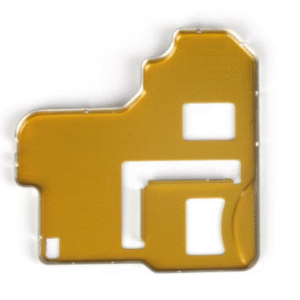
Advantages:
Excellent Electrical Conductivity:Provides very high Electric Field (E-field) shielding effectiveness, especially at high frequencies.
Good Corrosion Resistance: Suitable especially for non-harsh indoor environments.
Excellent Formability: Easy to stamp, bend, deep draw. Low work hardening rate means longer die life, ideal for complex shapes.
Good Solderability: Often solderable without special plating.
Aesthetic: Natural gold color sometimes used for visible components.
Disadvantages:
Higher Cost: Raw material cost usually higher than stainless steel.
Lower Strength:Less robust than stainless steel; larger cans or those needing support may require thicker material or ribs.
Poor Magnetic Shielding: Non-magnetic, offers weak low-frequency magnetic field (H-field) shielding.
Risk of Stress Corrosion Cracking (SCC): Can crack under stress in specific environments (e.g., containing ammonia).
Best For: Applications needing extremely high high-frequency SE, complex geometries, easy soldering; where magnetic shielding is less critical. Common in high-frequency communication modules, RF circuits, precision instruments.
5.Other Materials & Considerations
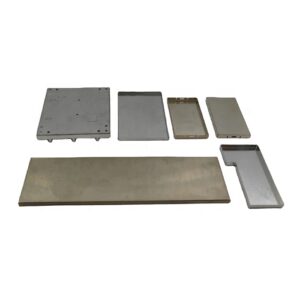
Pre-Plated Materials: Base materials (e.g., steel) pre-plated with nickel, tin, silver, etc., to improve solderability, corrosion resistance, or appearance. Simplifies your secondary plating process.
Aluminum: Lightweight, good conductivity, but poor formability (usually cast or machined, not stamped), difficult to solder. Less common for stamped shields.
Laminated/Composite Materials: E.g., steel/copper/steel sandwiches attempting to combine steel strength with copper conductivity. High cost, complex processing, limited use.
Conductive Gaskets/Elastomers: While not the can material itself, often used with metal cans at seams. Gasket material choice (silicone backing + metal/conductive particle filler) must also be compatible with the can material.
How to Choose? Your Material Selection Checklist
Key questions to ask (guide your engineers to define their needs):
1. What is the Primary Shielding Threat?
High-Frequency Noise (RFI)? -> Prioritize Conductivity (Brass, Nickel Silver).
Low-Frequency Magnetic Fields (e.g., power transformers)? -> Requires Permeability (Stainless Steel).
Mixed Threats? -> May require balancing or special design.
2. What is the Operating Frequency Range?
Higher Frequencies (>1GHz) -> Conductivity becomes more critical (Copper alloy advantage).
Lower Frequencies (<100MHz) -> Permeability of Stainless Steel may be more effective.
3. What are the Environmental Conditions?
High humidity, salt spray, chemical exposure? -> Prioritize High Corrosion Resistance (SUS 304 Stainless, Nickel Silver).
High Temperature? -> Consider material annealing temperature and plating limitations.
4. What are the Mechanical Requirements?
Need high strength/support? -> Stainless Steel (SUS 304/301).
Need complex deep-drawn shapes? -> Brassor Nickel Silver (Superior Formability).
Need spring contacts, clips, or frequent removal? -> Phosphor Bronze (C5191) or SUS 301 (High Elasticity).
Weight sensitive? -> Consider Density (Aluminum lightest but hard to stamp; Stainless Steel heavier).
5. What are the Soldering Requirements?
Reflow? Spot weld? Laser weld? Hand solder? -> Material & surface finish (plating) MUST be compatible. Brass/Nickel Silver generally solder well; Stainless Steel usually requires Nickel plating.
6. What are the Budget Constraints?
Cost Sensitive -> Stainless Steel is usually the baseline choice.
Performance Priority -> Consider Copper Alloys (Brass, Phosphor Bronze, Nickel Silver), but assess if the added value (performance gain, yield improvement, longer life) justifies the extra cost.
7. What is the Volume & Manufacturability Need?
Very High Volume -> Material work hardening rate (e.g., SUS 301) impacting die wear/maintenance costs becomes critical. Brass usually offers the longest die life.
Complex Design -> Choose Highly Formable** materials (Brass, Nickel Silver).

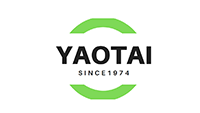
Leave A Comment